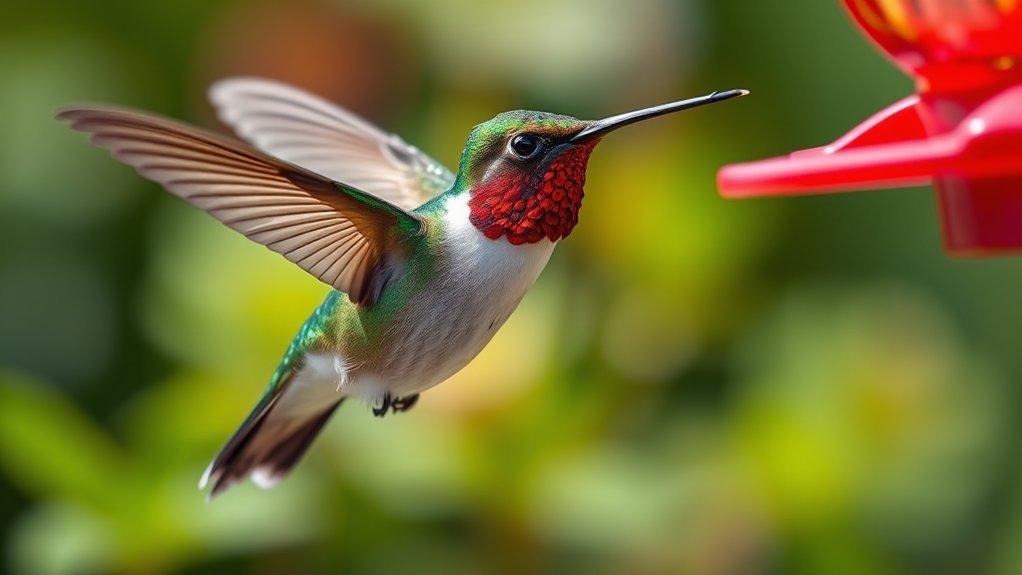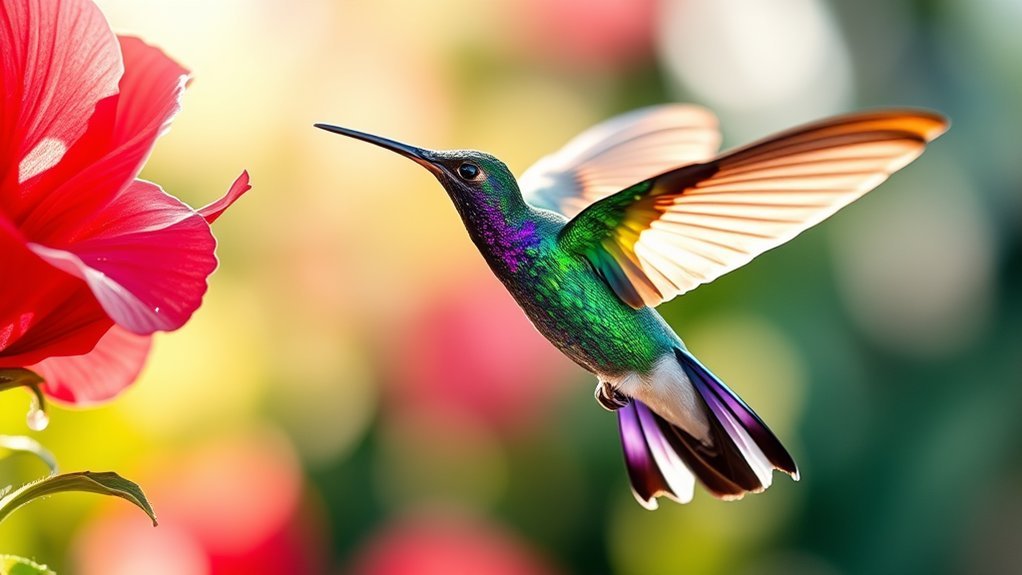Hummingbirds in Missouri: Identification and Attraction Tips
To attract hummingbirds to your Missouri garden, start by identifying the two main types: Ruby-throated and Rufous hummingbirds. Each has unique colors and patterns. Choosing the right plants can make your garden more appealing to these birds. Use bright, tubular flowers such as trumpet vine, bee balm, and salvia that produce nectar.
Next, place feeders in visible spots and fill them with a sugar-water mixture (one part sugar to four parts water). Clean the feeders regularly to keep the nectar fresh.
Consider adding perches near the feeders that allow hummingbirds to rest.
By following these steps, you can create an inviting environment for hummingbirds in your garden. Enjoy watching these amazing birds visit your space.
Key Takeaways
- Identify the Ruby-throated Hummingbird by its shiny green back and bright red throat; females have duller feathers and white throats.
- To attract hummingbirds, plant native flowers such as bee balm and trumpet vine. Choose bright colors, especially red and pink.
- Create a variety of plant heights and provide shelter to protect hummingbirds from predators and offer places to feed.
- Make nectar by mixing 1 part sugar with 4 parts water and boiling it to dissolve. Clean feeders every 3 to 5 days.
- Help conservation efforts by joining local habitat restoration projects and supporting the preservation of native plants.
Hummingbirds are delightful visitors. Observing them can bring joy to any garden. By following these tips, you can create an inviting space for these beautiful creatures. Enjoy the vibrant colors and lively activity they bring!
Overview of Hummingbirds in Missouri

Hummingbirds are fascinating birds that play an important role in Missouri's ecosystem, particularly in the warm months when they migrate through the state. These small birds thrive in various habitats across Missouri, including colorful gardens, wooded areas, and suburban landscapes.
The warm summers and mild winters of Missouri provide ideal conditions for hummingbirds to feed and breed.
To attract hummingbirds, you can create inviting spaces by planting native flowers that are rich in nectar and by placing feeders in sunny locations. This increases your chances of observing these beautiful birds.
Engaging with hummingbirds helps you connect to nature and appreciate Missouri's diverse ecosystem. Enjoy the beauty and joy these creatures bring.
Common Hummingbird Species in Missouri
Missouri hosts several species of hummingbirds, each with unique traits. The most common species include the Ruby-throated Hummingbird, Rufous Hummingbird, and Black-chinned Hummingbird.
The Ruby-throated Hummingbird has an iridescent green back and a striking red throat. It displays impressive flying skills.
The Rufous Hummingbird has vibrant rust-colored feathers and is known for migrating long distances.
The Black-chinned Hummingbird has a black throat with a shining purple band.
To attract these birds, it helps to understand their behaviors, such as feeding and territorial displays.
Ruby-throated Hummingbird: Identifying Features

The Ruby-throated Hummingbird is a captivating bird commonly seen in gardens. It measures about 3 to 5 inches in length.
Males have bright emerald-green backs and a shiny ruby-red throat that sparkles in sunlight, which makes them easy to identify.
Females have more muted colors, with a white throat and a lightly patterned underside that helps them blend into their surroundings.
Pay attention to their wing patterns, as some may show hints of brown or gray.
Spotting this beautiful bird can bring joy and wonder to your garden.
Rufous Hummingbird: A Lesser-Known Visitor
While the Ruby-throated Hummingbird is the most common species in the area, the Rufous Hummingbird is a less well-known visitor in Missouri. This bird adds variety to the local hummingbird population.
To identify a Rufous Hummingbird, look for its bright orange and rust-colored feathers, which are especially noticeable in males. They've long, straight bills that also help distinguish them.
Although not frequently seen, Rufous Hummingbirds migrate through Missouri from late summer to early fall. Watch for them as they travel south.
You can attract these unique birds by placing feeders and planting native flowers in your yard. This can improve your hummingbird watching experience.
Calliope Hummingbird: Rare Sightings in Missouri

The Calliope Hummingbird is a rare sight in Missouri. This tiny bird is one of the smallest in North America, measuring about 3 inches long. To see one, visit during late summer or early fall, as this is their migration period.
To identify a male Calliope, look for its bright iridescent throat, which shines in pink and purple. This contrasts with its green back and white-tipped feathers.
Females don't have these colors, making them harder to spot. These hummingbirds are likely to visit areas with plenty of nectar-rich flowers and feeders.
Enjoy the excitement of spotting this beautiful bird in Missouri!
Behavior and Feeding Habits of Hummingbirds
Hummingbirds show interesting behaviors and feeding habits that set them apart from other North American birds.
Male hummingbirds perform courtship displays, flying in aerial patterns to attract females. These displays are captivating and highlight their speed and colorful feathers.
Hummingbirds also defend their feeding areas fiercely, chasing away other birds to protect their access to nectar.
When they feed, you can see them hover while drinking from flowers or feeders. Their fast wing beats allow them to move quickly between blooms, helping them gather energy efficiently.
Learning about these behaviors can help you appreciate these amazing birds and their role in nature.
Creating a Hummingbird-Friendly Garden
To attract hummingbirds to your yard, create a hummingbird-friendly garden. Follow these four simple tips:
- Choose Native Plants: Select flowers like bee balm, trumpet vine, and columbine for their nectar.
- Use Bright Colors: Include a variety of colors, particularly red and pink, to draw in hummingbirds.
- Create Height Variety: Arrange plants at different heights to provide shelter and feeding spots.
- Provide Water: Install a shallow birdbath or misters for water sources that hummingbirds need to drink and bathe.
These strategies will help you create a welcoming environment for hummingbirds, letting you enjoy their vibrant presence.
Choosing the Right Hummingbird Feeder
Choosing a Hummingbird Feeder
When you choose a hummingbird feeder, focus on both functionality and design to attract these birds to your garden. For materials, opt for glass or sturdy plastics. These resist fading and are easy to clean. Avoid low-quality materials that may break down quickly or release harmful chemicals.
Placement of the feeder is also key. Put your feeder where it's easy to see, close to native plants or flowers. This creates a friendly atmosphere for the birds.
Keep it sheltered from strong winds and direct sunlight to ensure the nectar stays fresh. Following these tips makes your garden more inviting and supports these beautiful birds.
Best Nectar Recipes for Hummingbirds
To create a good feeding station for hummingbirds, you need a suitable feeder and an effective nectar recipe. A quality nectar attracts hummingbirds and meets their energy needs.
Here are simple nectar recipes:
- Basic Sugar Water: Mix 1 part sugar with 4 parts water. Boil the mixture to dissolve the sugar.
- Natural Flavoring: Add 1 teaspoon of vanilla extract to the basic recipe for extra flavor.
- Fruit Infusion: Use seasonal fruits like oranges to add color and taste to the nectar.
- Cleanliness: Clean the feeder every 3-5 days. This helps prevent mold and bacteria, keeping the feeding area safe.
With these recipes, you can attract hummingbirds and enjoy their lively presence!
Seasonal Migration Patterns of Hummingbirds
Every year, millions of hummingbirds begin their migration. They travel thousands of miles between breeding and wintering areas.
In Missouri, you can see this migration in spring, usually from mid-March to early May. During this time, hummingbirds search for blooming flowers and feeders to restore their energy after their long journey.
In the fall, from mid-August to October, these birds migrate south to find warmer weather. Knowing these migration patterns helps you prepare nectar and manage feeders. This preparation ensures you're ready when the hummingbirds arrive and provides the support they need during their journeys.
Enjoy the beauty of these amazing birds as they travel through your area!
Tips for Observing Hummingbirds
To enjoy watching hummingbirds, place your feeders where they're easy to see and protected from strong winds and harsh midday sunlight. This increases visits and improves your experience.
Keep your feeders clean and inviting. Here are some tips to improve your setup:
- Mix nectar using a 4:1 water-to-sugar ratio and refill it regularly.
- Clean feeders every few days, especially in hot weather.
- Plant native flowers nearby to draw in more hummingbirds.
- Watch in the early morning or late afternoon when hummingbird activity is highest.
Following these tips will help you appreciate these beautiful birds and feel more connected to nature.
Common Challenges Hummingbirds Face
Hummingbirds face several challenges that impact their survival. One major issue is habitat loss. Urban development and farming reduce the natural spaces where hummingbirds live. This decrease limits their access to flowers rich in nectar and safe places to build nests. As a result, it becomes harder for them to thrive.
Climate change also affects hummingbirds. It disrupts their migration and the availability of food. Changes in temperature and weather can lead to fewer hummingbirds visiting your garden at different times of the year.
Understanding these challenges can help us appreciate these incredible birds. Additionally, it encourages us to engage in mindful gardening and conservation efforts.
Conservation Efforts for Hummingbirds in Missouri
Conservation efforts for hummingbirds in Missouri are important.
You can help by preserving their habitats and using native plants. Here are steps you can take:
- Plant native flowers like bee balm and columbine to attract hummingbirds.
- Create a hummingbird-friendly garden with water sources and places for them to shelter.
- Avoid harmful pesticides that can hurt hummingbirds and their food sources.
- Join local conservation groups to help with habitat restoration and to raise awareness.
Frequently Asked Questions
What Colors Attract Hummingbirds Most Effectively?
To attract hummingbirds, use red flowers and feeders. Hummingbirds love bright red colors. Adding these colors to your garden or feeder will help draw in these beautiful birds. Enjoy watching them visit your space!
How Can I Keep My Feeder Ant-Free?
To keep your feeder free of ants, use simple strategies like moats or barriers. Clean your feeder regularly to remove any residues that attract ants. This will help keep the area welcoming for hummingbirds while keeping pests away. Enjoy watching the hummingbirds without the distraction of ants!
Do Hummingbirds Migrate Alone or in Groups?
Hummingbirds usually migrate alone. This behavior is part of their migration pattern. Some may join small groups, but they prefer to travel solo. This helps them follow their own routes. Traveling alone allows them to find food and suitable nesting spots more easily.
What Time of Day Are Hummingbirds Most Active?
Hummingbirds are most active at dawn and dusk. During these times, you can see them feeding frequently. They gather energy for the day ahead and prepare for rest in the evening. Observing them is a delightful experience, as their quick movements and vibrant colors capture attention.
Can I Attract Hummingbirds With Native Plants?
Yes, you can attract hummingbirds with native plants. By planting a variety of these species in your garden, you will create a lively environment that draws hummingbirds. This addition will also enhance the beauty of your outdoor space and provide a delightful experience for you and your visitors. Choose bright-colored flowers, as they appeal to hummingbirds and can make your garden more vibrant.

Kashvi is a passionate bird enthusiast and nature lover who has been fascinated by the world of birds for years. With a keen eye for detail and a love for learning, Kashvi is dedicated to sharing her knowledge and insights with fellow bird enthusiasts on Avian Enthusiasts. Through her engaging and informative articles, Kashvi aims to inspire others to join her in exploring the fascinating world of birds and to promote a deeper appreciation for these incredible creatures.







